Getting hair dye out of hardwood floors can be a challenging task, but with the right techniques and products, it’s possible to restore your floors to their original condition. Whether you accidentally spilled hair dye while coloring your hair or noticed stains on your hardwood floors, knowing how to effectively remove hair dye stains is essential.
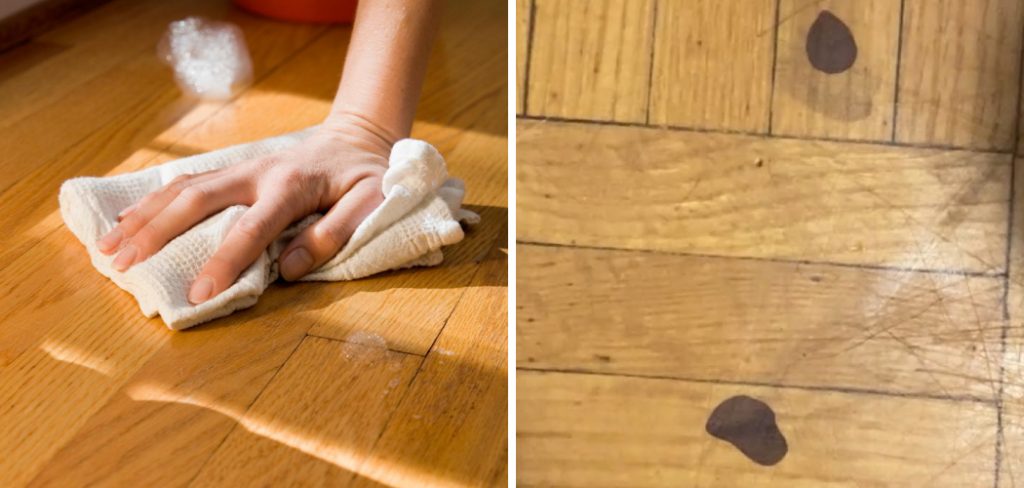
In this guide, we’ll explore various methods for how to get hair dye out of hardwood floors without causing damage or discoloration. From gentle cleaning solutions to specialized stain removers, we’ll provide step-by-step instructions to help you tackle hair dye stains and restore the beauty of your hardwood floors.
With a little patience and the right approach, you can successfully eliminate hair dye stains and maintain the pristine appearance of your hardwood flooring.
The Challenge of Removing Hair Dye from Hardwood Floors
Removing hair dye from hardwood floors presents a unique set of challenges that stem from the nature of both the stain and the surface. Hardwood floors are prized for their beauty and durability, but they can be susceptible to damage from harsh chemicals and excessive moisture. Hair dye, being designed to permanently alter the color of hair fibers, contains potent ingredients that can similarly bond with the wood’s surface, making removal troublesome.
The key difficulty lies in penetrating the stain without compromising the integrity of the wood’s finish or its natural grain. Additionally, the longer a hair dye stain remains on the hardwood, the more it sets into the wood, further complicating removal efforts. Successful eradication of such stains requires a careful balance between effective stain removal and preserving the condition and appearance of the hardwood flooring.
Importance of Prompt and Effective Action
The importance of promptly and effectively addressing hair dye stains on hardwood floors cannot be overstated. Acting swiftly not only prevents the dye from penetrating deeper into the wood but also significantly increases the likelihood of complete removal without leaving any residual marks.
Delayed action allows the dye to set into the wood, bonding with the material and making it far more challenging to eradicate without resorting to aggressive methods that might damage the floor’s finish. Effective action, characterized by the use of appropriate cleaning solutions and techniques tailored for hardwood floors, ensures the preservation of the floor’s aesthetics and longevity.
By responding immediately and utilizing the right approach, you can mitigate the impact of the stain and maintain your hardwood floor’s pristine condition, ultimately safeguarding your investment and the beauty of your home.
Understanding Hair Dye Stains
Hair dye stains on hardwood floors are not merely a result of dye coming into contact with the surface; they are complex interactions between the dye’s chemical makeup and the wood’s porous nature. Hair dyes consist of various chemicals, including colorants, alkalizers, and sometimes, metallic salts, all of which can penetrate the wood’s surface, making the stain more than just a superficial blemish.
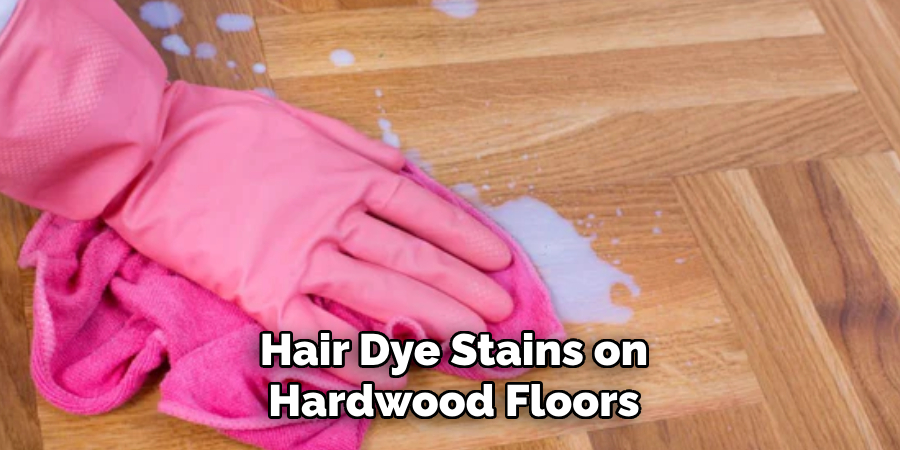
The wood’s porosity, finish type, and age can significantly influence how deeply the dye penetrates and how it reacts with the wood. Older floors with worn-out finishes or untreated wood are particularly vulnerable, as the lack of protective coating allows the dye easier access into the wood fibers.
Understanding the composition of hair dye and the characteristics of hardwood floors is pivotal in formulating an effective approach for stain removal. This knowledge not only assists in choosing the right cleaning agents but also in applying them in a manner that ensures the integrity and appearance of the floors are maintained.
Composition of Hair Dye and Its Staining Properties
The unique staining properties of hair dye stem from its composition, designed to ensure lasting color on hair fibers. Hair dyes typically contain various chemicals, including ammonia or ethanolamine, peroxide, and direct dyes, that work together to penetrate the hair shaft and deposit color.
Ammonia or ethanolamine opens the hair cuticle to allow the color to enter, while peroxide helps to oxidize the original hair color, clearing the way for the new color to bond. The direct dyes are responsible for the new color, providing the vibrant hues that adhere to the hair — and unfortunately to hardwood floors in the case of spills.
When hair dye comes into contact with hardwood floors, the same properties that allow it to bond with hair fibers can cause the dye to seep into the wood’s pores, resulting in a stubborn stain.
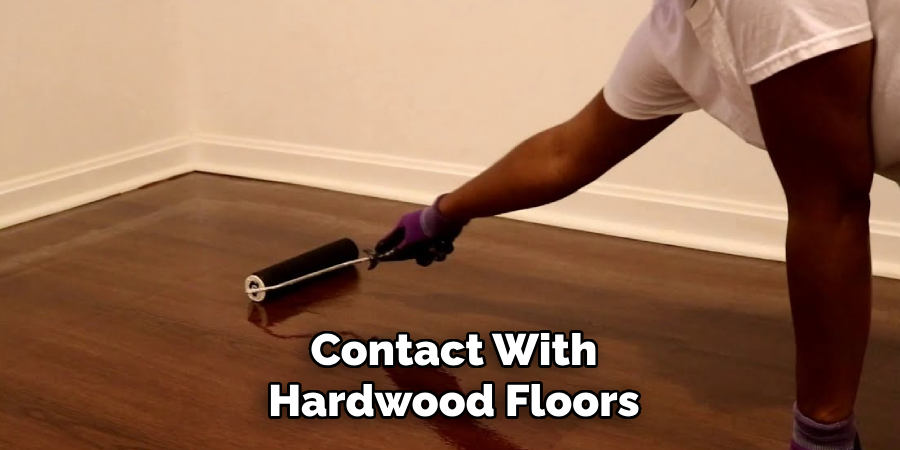
The pigments in the dye adhere to the wood, and without swift action, can penetrate beyond the surface layer, making the stain more challenging to remove. The chemical composition of hair dye is designed to resist fading, which is advantageous for hair color longevity but problematic when it comes to accidental spills on porous materials like wood.
Recognizing the composition of hair dye and its inherent staining properties is crucial for understanding why these stains are particularly resilient on hardwood floors. This knowledge is essential for selecting the most effective cleaning solutions and techniques to address the stains while minimizing damage to the wood’s finish and maintaining its natural beauty.
Potential Damage to Hardwood Floors
The potential damage to hardwood floors from hair dye stains extends beyond mere aesthetic concerns; it can affect the structural integrity and longevity of the flooring. Harsh chemicals found in some cleaning products, if used improperly, can strip away the floor’s protective finish, leaving it more vulnerable to scratches, dents, and water damage.
Additionally, aggressive scrubbing techniques aimed at removing stubborn stains can lead to the deterioration of the wood’s surface, compromising its smoothness and uniform appearance. The use of inappropriate cleaning solutions can also result in discoloration of the wood, where the affected area either becomes lighter or darker than the surrounding floor, creating unsightly patches that are difficult to reverse.
In severe cases, the solvent used to remove the stain might penetrate too deeply, causing the wood to warp or swell, leading to costly repairs or replacement of the affected planks. Therefore, understanding the delicate balance between effective stain removal and preserving the integrity of hardwood floors is crucial to avoid inadvertently causing long-term damage.
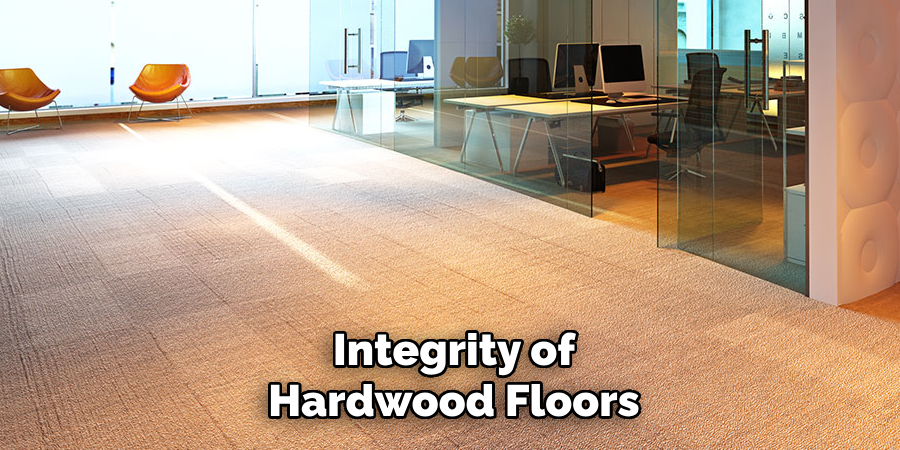
Assessing the Severity of the Stain
Before attempting to remove a hair dye stain from hardwood floors, it’s essential to assess the severity of the stain, as this will dictate the most appropriate cleaning method. The evaluation process involves examining both the size and depth of the stain, as well as the duration it has been on the floor.
A fresh spill, where the dye has not had sufficient time to penetrate deeply into the wood, is often less severe and may be treated with less aggressive cleaning methods. Conversely, older stains that have been left to set can penetrate deeper into the wood fibers, requiring more intensive cleaning solutions and methodologies to effectively remove them without causing damage to the floor.
Additionally, the stain’s color intensity and the type of hardwood floor finish can also influence the severity assessment. Darker dyes on lighter wood finishes might appear more pronounced, making the stain more noticeable and potentially more challenging to remove completely. In some cases, a superficial stain might only affect the floor’s finish and not the wood itself, making it easier to address without resorting to sanding or refinishing.
Understanding the extent of the stain’s penetration and its overall impact on the flooring material is crucial. This preliminary assessment helps in tailoring a specific approach that effectively removes the stain while preserving the integrity and aesthetic appeal of the hardwood floor.
10 Methods How to Get Hair Dye Out of Hardwood Floors
1. Act Quickly:
If you spill hair dye on your hardwood floors, it’s essential to act quickly to prevent the dye from penetrating the wood and causing permanent staining. Grab a clean cloth or paper towel and blot the stain gently to absorb as much of the dye as possible before it sets. Do not rub the stain, as this can spread it and make it more difficult to remove.
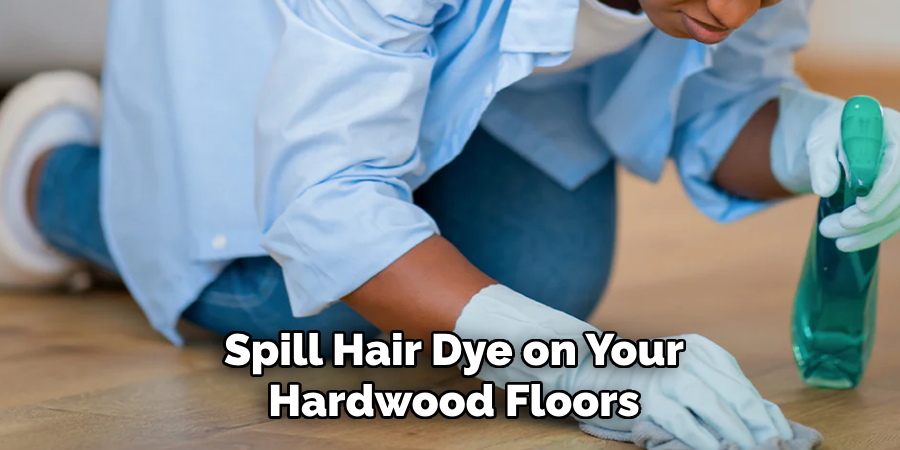
2. Use Dish Soap and Water:
Mix a few drops of dish soap with warm water to create a gentle cleaning solution. Dampen a clean cloth with the soapy water and gently blot the hair dye stain on the hardwood floor. Avoid scrubbing too vigorously, as this can damage the wood finish. Continue blotting until the stain starts to fade.
Once the stain has faded, use a clean damp cloth to remove any soap residue from the floor. Then dry the area with a towel or allow it to air dry completely. Repeat this process if necessary until the hair dye stain is completely gone.
3. Try Vinegar and Water Solution:
Vinegar is a natural stain remover that can help lift hair dye stains from hardwood floors. Mix equal parts white vinegar and water in a spray bottle and spritz the stained area. Let the solution sit for a few minutes, then blot the stain with a clean cloth. Repeat as necessary until the stain fades. Vinegar also has a strong odor, so be sure to ventilate the room while using this solution.
4. Baking Soda Paste:
Baking soda is another natural remedy for removing hair dye stains from hardwood floors. Mix baking soda with a small amount of water to create a paste, then apply it to the stained area.
Gently scrub the paste into the stain with a soft-bristled brush, then wipe it away with a damp cloth. Repeat this process until the stain is completely gone. While baking soda is generally safe for hardwood floors, it’s always a good idea to test it on a small, inconspicuous area first.
5. Hydrogen Peroxide:
Hydrogen peroxide is a powerful stain remover that can effectively break down hair dye stains on hardwood floors. Apply a small amount of hydrogen peroxide directly to the stain and let it sit for a few minutes. Blot the stain with a clean cloth until it lifts away, then rinse the area with water. Repeat if necessary.
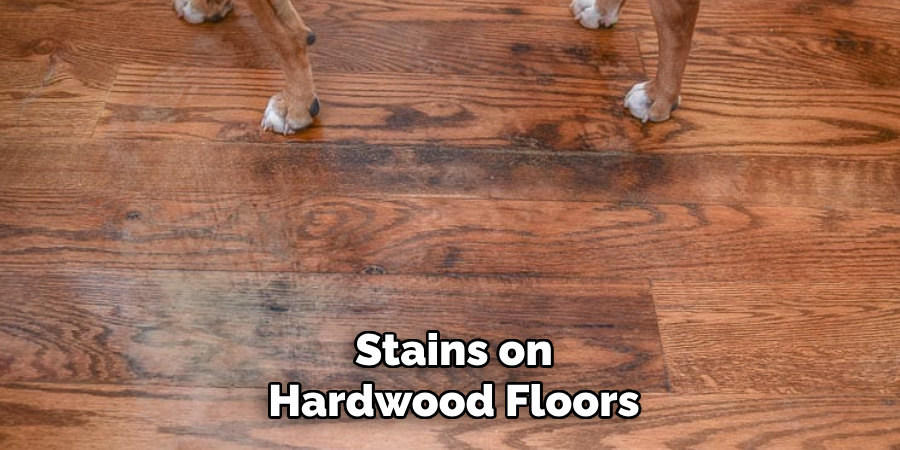
Hydrogen peroxide is a chemical compound with the formula H2O2. It is a clear liquid with a slightly bitter taste and can be found in many household cleaning products. This versatile chemical has many uses, including as a disinfectant, bleaching agent, and even as an alternative fuel source.
6. Rubbing Alcohol:
Rubbing alcohol can help dissolve hair dye stains on hardwood floors. Dampen a clean cloth with rubbing alcohol and gently blot the stained area. Repeat as necessary until the stain disappears, then rinse the area with water and dry it thoroughly. Rubbing alcohol can also be used to remove permanent marker stains from hard surfaces such as wood, plastic, and metal.
In addition to its stain-removing properties, rubbing alcohol is a useful disinfectant. It can kill germs and bacteria on surfaces, making it an effective cleaning agent for household use. To disinfect surfaces, simply spray or wipe them down with rubbing alcohol and let it air dry. It can also be used to clean and disinfect electronics, such as computer keyboards and screens.
7. Oxygen Bleach:
Oxygen bleach is a safe and effective cleaner for hardwood floors that can help lift hair dye stains. Mix oxygen bleach with water according to the package instructions and apply it to the stained area. Let it sit for a few minutes, then scrub the stain with a soft-bristled brush. Rinse the area with water and dry it thoroughly. Repeat the process if necessary.
Oxygen bleach, also known as sodium percarbonate, is an environmentally friendly alternative to traditional chlorine bleach. It works by releasing oxygen when mixed with water, which helps break down and remove stains without damaging surfaces or emitting harmful fumes.
In addition to removing hair dye stains from hardwood floors, oxygen bleach can be used for a variety of cleaning tasks, including removing stains from clothing, carpets, and upholstery. It can also be used to clean grout, tiles, and even outdoor surfaces like decks and patios.
8. Commercial Stain Removers:
There are many commercial stain removers available specifically designed for removing hair dye stains from hardwood floors. Follow the manufacturer’s instructions for application and use caution to avoid damaging the wood finish. It is always a good idea to test the product on a small, inconspicuous area first before applying it to the entire stained area.
In addition to commercial stain removers, there are also natural and DIY solutions that can be effective in removing hair dye stains from hardwood floors. Some popular options include using a mixture of baking soda and water, lemon juice, white vinegar, or hydrogen peroxide. These ingredients can be combined and applied to the stain, left to sit for a few minutes, and then scrubbed with a soft cloth or brush.
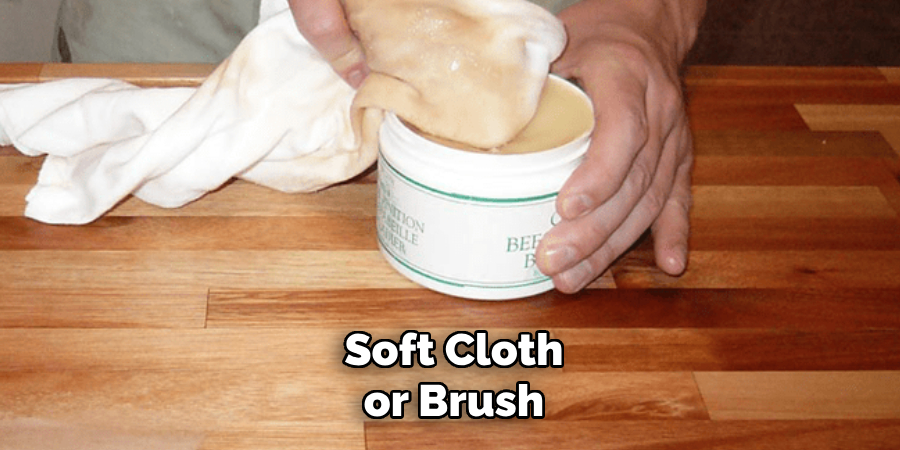
9. Light Sanding:
If the hair dye stain is stubborn and won’t come out with gentle cleaning methods, you may need to resort to light sanding. Use fine-grit sandpaper to sand away the stained area, being careful not to sand too deeply and damage the wood. Once the stain is removed, refinish the sanded area to match the rest of the floor.
Note: Sanding should always be done as a last resort, as it can permanently damage the wood if not done carefully and correctly. It is important to test on a small, inconspicuous area first before sanding the entire stained area.
It’s also worth mentioning that light sanding may not completely remove the hair dye stain, especially if it has already penetrated deep into the wood. In these cases, it may be best to seek professional help or consider replacing the affected boards entirely.
10. Preventative Measures:
To prevent hair dye stains on hardwood floors in the future, consider laying down protective mats or rugs in areas where hair dyeing occurs. Clean up any spills or splatters immediately to prevent the dye from staining the wood. Additionally, place a towel or cloth under the area where you will be dyeing your hair to catch any stray drops.
Using a barrier cream or petroleum jelly around the hairline and ears can also prevent hair dye from staining the skin and subsequently transferring onto hardwood floors. Make sure to thoroughly wipe off any excess barrier cream before it has a chance to drip or smear on the floor.
Furthermore, investing in a good quality hair dye that is less likely to drip or splatter can also help prevent staining on hardwood floors. Follow the instructions carefully and avoid over-saturating your hair with dye during application.
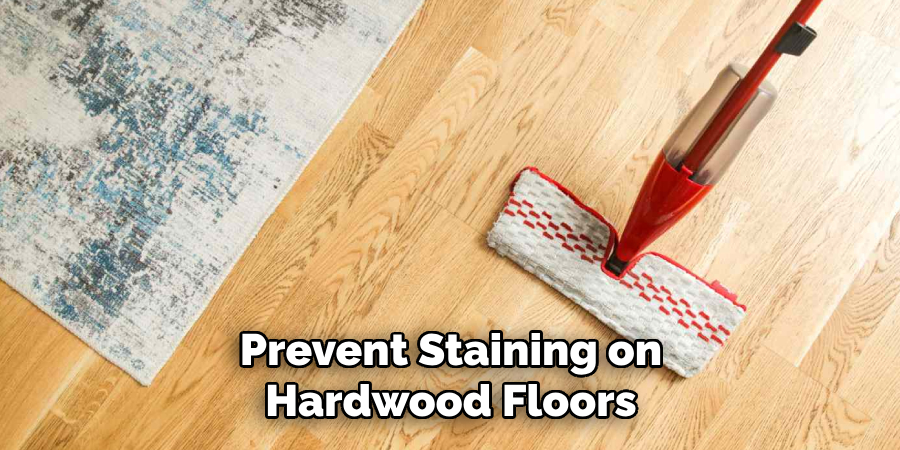
Conclusion
In conclusion, effectively removing hair dye stains from hardwood floors requires patience, diligence, and the right techniques. This comprehensive guide offers various methods, from gentle cleaning solutions to specialized treatments, to tackle even the most stubborn stains.
By promptly addressing hair dye spills and stains and employing the appropriate cleaning techniques, you can restore the beauty and integrity of your hardwood floors. Remember to test any cleaning method in a discreet area first and avoid harsh scrubbing to prevent damage to the wood surface.
Additionally, implementing preventative measures such as using protective mats and conducting regular maintenance can help minimize the risk of future stains. Thanks for reading, and we hope this has given you some inspiration on how to get hair dye out of hardwood floors!
About the Author
Adrian Green, a lifelong woodworking enthusiast, shares his passion for the craft through The Woodenify Blog. With a foundation built on years of hands-on experience in his father’s woodworking shop, Adrian is dedicated to helping others learn and grow in the world of DIY woodworking. His approach to woodworking combines creativity, practicality, and a deep appreciation for the art of building with your own hands. Through his blog, he inspires individuals of all skill levels to embark on their own woodworking journeys, creating beautiful, functional pieces of furniture and décor.
Professional Focus
- Specializes in DIY woodworking projects, from furniture to home décor.
- Provides step-by-step guides and practical tutorials for woodworkers of all skill levels.
- Dedicated to helping readers build confidence and skill through easy-to-follow instructions and tips.
- Passionate about fostering a community of makers who can share, learn, and grow together.
Education History
- University of Craft and Design – Bachelor of Fine Arts (BFA) in Woodworking and Furniture Design
- Woodworking Apprenticeships – Extensive hands-on training with skilled craftsmen to refine carpentry and furniture making techniques.
- Online Courses & Masterclasses – Continued education in advanced woodworking techniques, design principles, and specialized tools
Expertise:
- DIY woodworking, carpentry, furniture making, and home décor projects.
- Creating accessible tutorials and guides for beginner to advanced woodworkers.
- Sharing the joys and satisfaction of woodworking, from raw materials to finished products.
